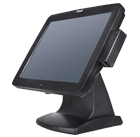Pos vs Desktop
We are creating new standards by realizing products that are best of their kind in their respective field.

- Standard industrial grade touch screen enabled hardware. POS is more user-friendly & mistake-proof. Easy to train cashier.
- Embedded and industrial design concept. Rugged, robust & reliable. Designed for dust protection & harsh retail environments.
- Minimum space needed due to high integration, it is less that the A4 size. Compact small form factor (SFF)
- Minimum power consumption due to usage of low power CPUs
- Integrated ALL-IN-ONE concept and hence minimum cabling. POS has better aesthetics in customer facing check-out counters
- Very high reliability & uptime, because of FANLESS system design. Retail checkout counters cannot afford high downtime.
- Comes with technical and software driver support for devices, peripherals. SDK and OPOS/JPOS drivers are available.
- POS is a long-term supported device directly from the Manufacturer.
- Longer life cycle. Minimum of 7 years Intel embedded roadmap
- No frequent change of models in POS. Hence frequent Software re- validation not required.
- 2 to 4 serial ports are standard in POS Systems
- POS Systems are GREEN devices with more energy efficiency
- Ideal for business use, where systems are typically used by many cashiers & where downtime is critical
- 3 year onsite comprehensive warranty, option available
- Low maintenance cost as spares are typically supported for minimum 7 years by manufacturer.
- POS systems are a better investment in the long term owing to low AMC, durability etc.
- Low total cost of ownership. (eg. TCO for desktop is Y then for POS it will be Y-25%)

- No touch screen enabled hardware. Desktops are operated using mouse & keyboard, hence prone to mistakes & errors in billing.
- Commercial and consumer grade design concept. Designed for mainly office & home use. Lesser service life compared to POS
- Desktop occupy more counter space as it comes with many separate devices.
- Very high power consumption as it uses high power CPUs
- Modular with many separate devices like System, Monitor, Keyboard etc and hence more cables and connection. More failures due to rodents and insects.
- Very poor reliability & uptime because of many moving parts and cooling fans which are subject to normal wear and tear.
- Do not include technical and software driver support for devices, peripherals
- Desktop is not a long-term supported device & it does not come directly from the Manufacturer.
- Lifecycle is short-term. Maximum 1 to 2 years.
- Frequent change of models in PCs. Hence frequent Software re- validation required.
- Serial ports not available.
- PCs are not energy efficient and not considered as GREEN devices.
- Ideal for private use in Offices, Home etc where the system is typically used by only one user.
- One-year onsite warranty
- High maintenance cost. Spares parts are not available beyond a certain period of time due to change of specs, forcing change of entire system
- Price is lower than that of POS (Eg. Desktop price = x then POS price will be x+25%)
- High total cost of ownership


